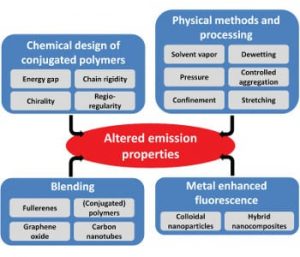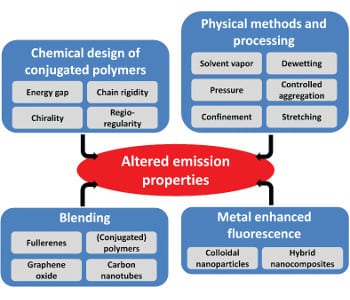 Nowadays, emission properties of polymeric semiconducting materials are largely employed in fabrication of all types of organic-based optoelectronic devices, including field-effect transistors (OFETs), light emitting diodes (OLEDs) and photovoltaics (OPVs) that are significantly improving our everyday life. However, a new review published in Polymer International (“Altering the emission properties of conjugated polymers”), with Dr. Ioan Botiz as lead author, touches upon an interesting fundamental question: how can we manipulate the features of polymeric semiconductors to improve OLEDs and other display applications?
Nowadays, emission properties of polymeric semiconducting materials are largely employed in fabrication of all types of organic-based optoelectronic devices, including field-effect transistors (OFETs), light emitting diodes (OLEDs) and photovoltaics (OPVs) that are significantly improving our everyday life. However, a new review published in Polymer International (“Altering the emission properties of conjugated polymers”), with Dr. Ioan Botiz as lead author, touches upon an interesting fundamental question: how can we manipulate the features of polymeric semiconductors to improve OLEDs and other display applications?
There have been several previous research articles by chemists on chemical design, by physicists on physical and processing methods and by materials scientists on blending different materials, trying to answer that fundamental question. However, there has not been an up-to-date review, combining all these processes and methods in one study.
As a result the goal of this review, co-authored by Simion Astilean (Professor and Head of the Molecular Spectroscopy Dpt. at the Babes-Bolyai University, Romania) and Natalie Stingelin (Professor of Functional Organic Materials at the Imperial College London, UK), is to combine the most important methods across different subject areas that can be employed to efficiently alter the emission properties of various macromolecular systems (e.g conjugated polymers).

a) Photograph of various conjugated polymeric solutions under UV light. b, c) chemical structures of different conjugated polymers.
As Dr. Botiz explains, “Researchers across different scientific fields who work on discovering methods to alter emission properties of materials might not be aware of the variety of methods that can efficiently alter the emission properties of macromolecular systems available in other fields (e.g. physics, materials science, etc.). However, new efficient processing methods will have to be continuously developed along with new materials in order to push the performance and stability of organic electronic devices to the next level”.

















